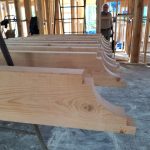
How Much Does a Home Addition Cost? Your Complete Guide
Discover How Much a Home Addition Costs and What Impacts the Price
If you’re asking, how much does a home addition cost, you’re not alone. Whether you’re dreaming of a sun-filled family room, an extra bedroom, or a cozy home office, adding space is one of the smartest investments you can make in your property. But understanding how much a home addition costs involves more than just picking a number. From square footage and design complexity to materials and labor, many factors shape the final price. In this guide, we’ll walk you through the essentials so you can budget smarter and build with confidence.
How much does a home addition cost
The simple answer is that your costs depend on a mix of size, scope, materials, and labor. Because every home addition is unique, there is no single figure that fits all projects. You might be looking at a small bump-out for a modest bedroom or a full second-story addition to double your living space. Each brings its own price range.
Despite the lack of universal figures, you can still shape a realistic budget by looking at key cost drivers. These include the square footage requirement, the complexity of your design, the grade of materials you select, and the typical labor rates in your area. If you are expanding in a region with higher wages and strict building codes, then you’ll likely see bigger numbers on your quote. The good news is, thorough planning and prioritizing what matters most to you can keep the project in line with your expectations.
While it’s tempting to look for a one-size-fits-all estimate, focus on your own unique needs and priorities for the best results.
Size and layout matters
The footprint and configuration often set your biggest budget portion. You might choose a small 100-square-foot laundry extension or sizeable family room with floor-to-ceiling windows.
- Square footage: More square feet means increased labor hours and higher costs for flooring, drywall, windows, and materials.
- Layout complexity: Straightforward rectangular layouts cost less than multiple angles, vaulted ceilings, or specialized nooks.
- Existing structure: Foundation or roof beam modifications require higher engineering and material expenses.
Consider how new spaces flow into existing areas. Expanding kitchens might require plumbing rerouting, making concurrent kitchen renovation efficient.
Sometimes bigger isn’t better well-designed smaller additions with smart storage can feel surprisingly spacious and comfortable.
Materials and finishes
Once you determine project size and shape, examine materials and finishes. Costs fluctuate between basic, mid-range, or luxury-grade options.
- Lumber, insulation, and framing: These structural components are your home’s backbone. Higher-grade materials cost more but offer better long-term performance.
- Exterior cladding and roofing: Matching existing materials may require special orders, increasing expenses.
- Interior surfaces: Flooring, paint, trim, lighting, and cabinetry drive costs based on style preferences.
Consider cost-effective alternatives like engineered quartz countertop instead of imported marble. Invest in difficult-to-replace items like windows or insulation while choosing budget-friendly options for easily updated features like paint or fixtures.
Finishes transform plain additions into beautiful living space extensions.
Design and labor factors
Beyond basic building shells, design complexity and labor hours quickly shape spending. Intricate additions custom archways, vaulted ceilings, ornate trim—require more contractor and tradesperson hours. Even small details like specialized tile patterns add labor costs.
Well-planned designs save headaches and expenses. Professional designers, architects, or structural engineers factor in load-bearing walls, rooflines, and climate considerations. Their experience prevents costly structural missteps or code violations.
Build partnerships with a professional remodeler. for guidance through site prep, structural planning, and material selection. If additions include showers or tubs, coordinate bathroom remodeling. simultaneously for cost-effectiveness.
Detailed upfront planning prevents surprises. Thorough designs and well-scoped contracts keep crews on schedule and within budget, minimizing expensive last-minute change orders.
Permits and regulations
Before framing walls, address local building codes, zoning requirements, and permits. Each municipality handles these differently, requiring multiple permits for structural, electrical, plumbing, or exterior changes. These rules ensure safety but introduce extra costs and time.
Budgets shift if regulators require code upgrades. Older homes might need updated electrical systems or better foundations, benefiting long-term but increasing upfront costs.
Permitting fees vary and are paid once designs finalize. Applications take weeks, so plan accordingly. Factor in site inspections and potential zoning board approvals for non-standard projects.
Consult knowledgeable builders about requirements. At home additions like Mazzamuto Construction, we’ve navigated local regulations since 1960, securing approvals for peace of mind.
Work with a professional remodeler
Although homeowners may tackle simple renovations themselves, larger home additions benefit greatly from professional oversight. Experienced contractors set realistic budgets, manage multiple trades, and avoid potential pitfalls while sourcing quality materials at fair prices.
Professional oversight can save money through effective space usage, durable yet affordable materials, and specialized laborers who work efficiently. Consider project complexity, safety needs, and your schedule before attempting DIY room extensions. Major structural work demands experts for safety and code compliance.
To understand typical responsibilities like permits and inspections, check out what does a professional remodeler do. For rate comparisons, see how much does a professional remodeler cost.
How Much Does a Home Addition Cost and Why It Matters
Home addition costs depend on your specific goals, home, and style preferences. Your budget is shaped by size, layout, materials, and design choices, while labor rates and local regulations affect timeline and expenses.
Start by identifying priorities: need simple office space or envision a large, bright family room? Being upfront about budget goals with your remodeler helps create realistic plans. Expect back-and-forth adjustments as details emerge—you don’t need perfect blueprints initially, just open communication about affordability versus desires.
Ready to Transform Your Home?
At Mazzamuto Construction, we believe great spaces start with thoughtful planning and skilled craftsmanship. Whether you’re exploring ideas or ready to build, our team is here to guide you every step of the way. Let’s bring your vision home—reach out for a personalized consultation today!
Frequently asked questions
1. How much does a home addition cost?
Home addition costs typically range from $20,000 to $200,000 or more, with most projects averaging $80 to $300 per square foot depending on the size, complexity, materials chosen, and local labor rates in your area.
2. What are the types of home additions?
The main types of home additions include room additions like bedrooms, bathrooms, and kitchens, structural additions such as second stories and bump-outs, and outdoor additions like covered patios, screened porches, and garage expansions.
3. Do I need an architect or just a contractor?
It depends on your project’s complexity. Some contractors offer in-house design, while others recommend hiring an architect for complicated additions. Working with both can help ensure your structure is sound and attractive, especially if you want something truly custom.
4. How long does a home addition take to build?
Timelines vary widely based on scope, design complexity, weather, and permit approvals. A small extension might finish in a few weeks, while a multi-room or second-story addition could take several months. For more details, see how long does a home addition take to build.
5. Is it cheaper to add on or move to a bigger home?
This is a personal choice that depends on property prices, neighborhood preferences, and how you value staying in your current location. Adding on might be cheaper if you love your home’s location, but moving might be more attractive if you already plan to relocate.
6. Will adding more rooms increase my property taxes?
In most places, any improvement that raises your home’s assessed value can lead to higher property taxes. The exact increase varies between municipalities, so it’s best to consult local tax guidelines or check with an assessor’s office.
7. Should I remodel my kitchen or bathrooms at the same time?
If those areas are adjacent to your planned addition, you can save on labor and potential disruption by doing them together. For instance, a kitchen renovation or full bathroom remodeling might be easier to tackle while your construction crew is already on-site.
Key takeaways
- Plan your size and layout first. Bigger footprints cost more, so be clear on how much additional space you really need.
- Choose materials wisely. Invest in robust structural elements that will last, but consider cost-effective finishes where you can.
- Expect design and labor to shape your budget. Complex details and skilled trades add to costs, but they also deliver quality results.
- Research permits and codes. Factoring these into both your timeline and your budget early helps you avoid last-minute surprises.




